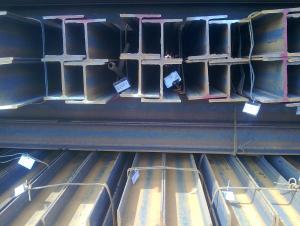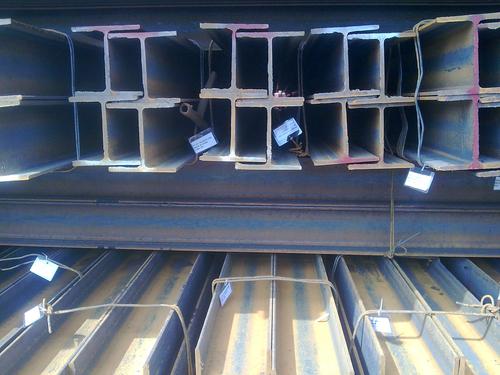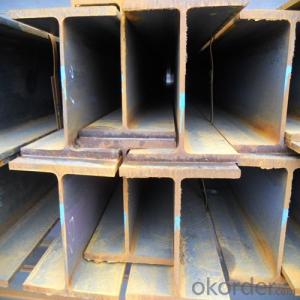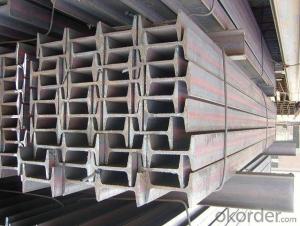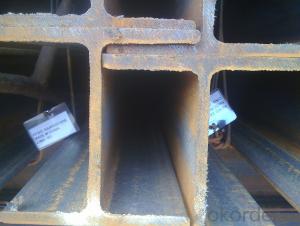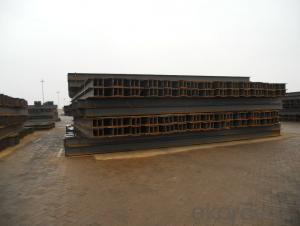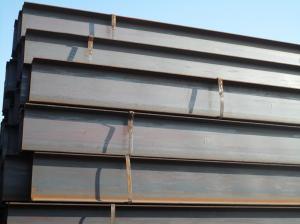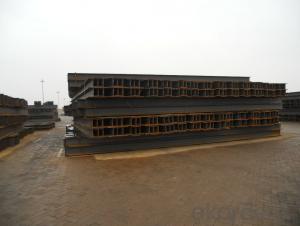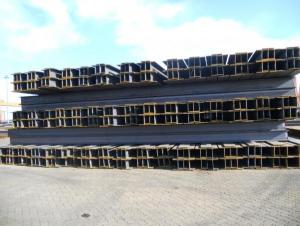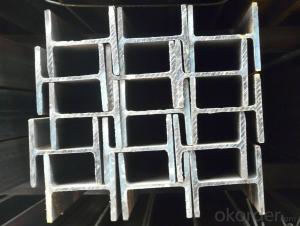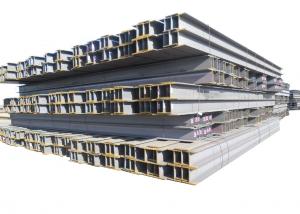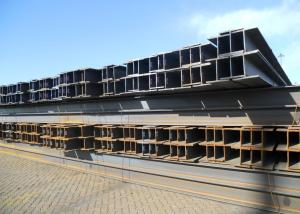Hot Rolled H-Beam SS400 JIS Standard
- Loading Port:
- China Main Port
- Payment Terms:
- TT or LC
- Min Order Qty:
- 100 m.t.
- Supply Capability:
- 10000 m.t./month
OKorder Service Pledge
OKorder Financial Service
You Might Also Like
Product Description:
OKorder is offering Hot Rolled H-Beam SS400 JIS Standard at great prices with worldwide shipping. Our supplier is a world-class manufacturer of steel, with our products utilized the world over. OKorder annually supplies products to African, South American and Asian markets. We provide quotations within 24 hours of receiving an inquiry and guarantee competitive prices.
Product Applications:
Hot Rolled H-Beam SS400 JIS Standard are ideal for structural applications and are widely used in the plant, high-rise building construction; the bridge, shipment building; lifting and transportation machinery, equipment manufacturing base building; the support, foundation pile manufacturing
Product Advantages:
OKorder's Hot Rolled H-Beam SS400 JIS Standard are durable, strong, and wide variety of sizes.
Main Product Features:
· Premium quality
· Prompt delivery & seaworthy packing (30 days after receiving deposit)
· Can be recycled and reused
· Mill test certification
· Professional Service
· Competitive pricing
Product Specifications:
Manufacture: Hot rolled
Grade: Q195 – 235
Certificates: ISO, SGS, BV, CIQ
Length: 12m, as per customer request
Packaging: Export packing, nude packing, bundled
size | Kg/m |
100*100 | 16.9 |
125*125 | 23.6 |
150*75 | 14 |
150*150 | 31.1 |
148*100 | 20.7 |
198*99 | 17.8 |
200*100 | 20.9 |
248*124 | 25.1 |
250*125 | 29 |
FAQ:
Q1: Why buy Materials & Equipment from OKorder.com?
A1: All products offered byOKorder.com are carefully selected from China's most reliable manufacturing enterprises. Through its ISO certifications, OKorder.com adheres to the highest standards and a commitment to supply chain safety and customer satisfaction.
Q2: How do we guarantee the quality of our products?
A2: We have established an advanced quality management system which conducts strict quality tests at every step, from raw materials to the final product. At the same time, we provide extensive follow-up service assurances as required.
Q3: How soon can we receive the product after purchase?
A3: Within three days of placing an order, we will arrange production. The normal sizes with the normal grade can be produced within one month. The specific shipping date is dependent upon international and government factors, the delivery to international main port about 45-60days.
Images:
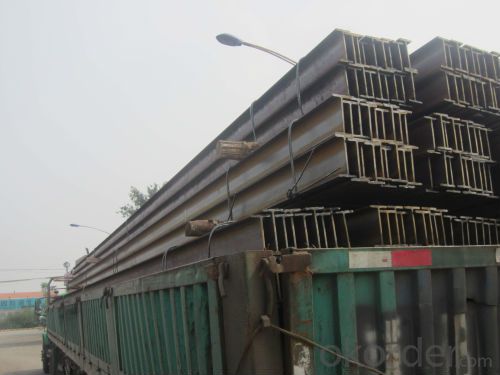
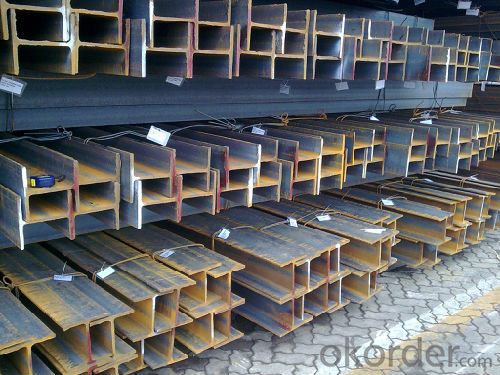
- Q: Are Steel H-Beams resistant to termite or insect damage?
- Yes, steel H-beams are resistant to termite or insect damage. Unlike wooden beams, steel beams do not provide a food source for termites or other insects, making them highly resistant to infestation. Steel beams are made from a combination of iron and carbon, which do not attract or support termite colonies. This resistance to termite or insect damage is one of the many advantages of using steel H-beams in construction projects, as it ensures the structural integrity and longevity of the beams.
- Q: How do you calculate the plastic section modulus of steel H-beams?
- To determine the plastic section modulus of steel H-beams, it is necessary to go through a series of steps. The plastic section modulus serves as a measure of the beam's resistance to bending and is crucial in establishing its load-carrying capability. Firstly, the geometry of the H-beam must be determined. The plastic section modulus relies on various dimensions, including the width, height, flange thickness, and web thickness of the H-beam. These measurements are typically provided by the manufacturer or can be directly measured. Next, the area of the H-beam must be calculated. This involves subtracting the area of the flanges from the area of the web. The formula for the H-beam's area is as follows: Area = (2 * flange thickness * flange width) + (web thickness * web height). The centroid of the H-beam needs to be calculated as well. The centroid represents the point at which the entire area of the H-beam can be considered to act. The formula for determining the centroid is: Centroid = (A1 * y1 + A2 * y2) / (A1 + A2). In this formula, A1 and A2 refer to the areas of the flanges and web, respectively, while y1 and y2 represent the distances from the centroid of each area to the neutral axis. The moment of inertia, which gauges the H-beam's resistance to bending, must also be calculated. The parallel axis theorem can be used to determine the moment of inertia. The formula for the moment of inertia is as follows: I = (A1 * y1^2) + (A2 * y2^2) + (A1 * (y1 - Centroid)^2) + (A2 * (y2 - Centroid)^2). In this formula, A1, A2, y1, y2, and Centroid are defined as in step 3. Finally, the plastic section modulus can be calculated by dividing the moment of inertia by the distance from the neutral axis to the extreme fiber, which is typically the point of maximum stress. The formula for the plastic section modulus is: Z = I / c. In this formula, Z represents the plastic section modulus, I denotes the moment of inertia, and c signifies the distance from the neutral axis to the extreme fiber. By following these steps and utilizing the appropriate formulas, one can accurately compute the plastic section modulus of steel H-beams. This value is crucial in ascertaining the beam's load-carrying capacity and its ability to withstand bending forces.
- Q: What are the typical applications of steel H-beams?
- Steel H-beams are commonly used in construction and structural engineering for various applications. They are widely used in building frameworks, bridges, and platforms, providing support and stability in heavy load-bearing structures. H-beams are also utilized in the construction of industrial buildings and warehouses, as well as in the manufacturing and automotive industries for the fabrication of machinery and equipment. Additionally, they find application in the construction of high-rise buildings, stadiums, and infrastructure projects, where their strength and durability are essential for withstanding heavy loads and structural integrity.
- Q: What are the common connections used for steel H-beams?
- The common connections used for steel H-beams are typically welded or bolted connections.
- Q: What are the different connection details for steel H-beams?
- There are several different connection details for steel H-beams, depending on the specific application and structural requirements. Some common connection details for steel H-beams include: 1. Welded Connection: This is the most commonly used connection detail for steel H-beams. It involves welding the flanges and web of the H-beam to the supporting structure or other steel members. Welded connections provide a strong and rigid connection, ensuring proper load transfer between the beams and the supporting structure. 2. Bolted Connection: In this type of connection, bolts are used to connect the flanges of the H-beams to the supporting structure or other steel members. Bolted connections offer ease of installation and flexibility in terms of disassembly and reassembly. They are suitable for applications where the connection needs to be adjustable or removable. 3. Moment Connection: A moment connection is designed to transfer both axial and bending moments between two H-beams. This type of connection is commonly used in multi-story buildings and bridges, where the transfer of significant loads and moments is required. Moment connections typically involve a combination of welded and bolted connections to ensure proper load transfer and stability. 4. Shear Connection: Shear connections are used to transfer shear forces between two H-beams. This type of connection is often used in structures where the shear force is the primary concern, such as in roof trusses or floor systems. Shear connections can be achieved through welding, bolting, or a combination of both. 5. Splice Connection: A splice connection is used to join two or more steel H-beams together to create longer or larger structural members. Splice connections can be achieved through welding or bolting, depending on the specific application and design requirements. Splice connections are commonly used in long-span structures, such as bridges and roof trusses. It is important to note that the selection of the connection detail for steel H-beams depends on various factors, including the structural design, load requirements, and the type of forces expected to act on the structure. The choice of the connection detail should be made in accordance with relevant structural codes and standards to ensure the safety and performance of the structure.
- Q: How are H-beams different from other types of beams?
- H-beams, also called hot-rolled steel beams, possess unique shape and structural properties that set them apart from other types of beams. Their cross-sectional shape, resembling the letter "H," gives them a higher strength-to-weight ratio in comparison to other beam types, enabling them to carry loads more efficiently. One of the primary advantages of H-beams lies in their exceptional load-bearing capacity. The horizontal flanges located at the top and bottom of the H-beam offer excellent resistance against bending and twisting forces, allowing them to support heavy loads without sagging or distorting. Consequently, H-beams are ideal for applications that necessitate long spans and high load-bearing capabilities, such as bridge construction, skyscrapers, and large structural frameworks. Another notable characteristic of H-beams is their versatility. Due to their unique shape, H-beams find extensive use in various industries. They are commonly employed in the construction sector for building frames, columns, and beams, as well as in the manufacturing industry for heavy machinery and equipment. Additionally, H-beams can be easily welded, bolted, or connected, facilitating their integration into diverse structural systems. Furthermore, H-beams provide cost-effective solutions in terms of material usage. Their optimized shape minimizes the amount of steel required, resulting in reduced costs and weight when compared to other beam types. Consequently, H-beams not only offer economic benefits but also enhance transportability and installation efficiency. In conclusion, H-beams differentiate themselves from other beams through their distinctive "H" shape, which grants them superior load-bearing capacity and versatility. Their ability to withstand heavy loads, ease of integration, and cost-effectiveness make them a popular choice in various construction and manufacturing applications.
- Q: What are the different design codes and standards for steel H-beams?
- There are several design codes and standards that govern the use of steel H-beams in construction. Some of the most commonly followed codes and standards include: 1. American Institute of Steel Construction (AISC): AISC 360 is the primary design code for steel structures in the United States. It provides guidelines for the design, fabrication, and erection of structural steel components, including H-beams. AISC 360 incorporates both ASD (Allowable Stress Design) and LRFD (Load and Resistance Factor Design) methods. 2. European Norm (EN): In Europe, steel structures are designed according to the Eurocode standards. Eurocode 3, specifically EN 1993-1-1, contains provisions for the design of steel structures, including H-beams. It provides guidance on the calculation of loads, material properties, and design criteria. 3. British Standards (BS): In the United Kingdom, steel design follows British Standards. BS 5950-1 is the code that covers the design of structural steelwork, including H-beams. It includes provisions for the calculation of loads, material properties, and design principles. 4. Australian Standards (AS): Australia has its own set of design standards for steel structures. AS 4100 is the code that governs the design of steel structures, including H-beams. It provides guidelines for the calculation of loads, material properties, and design principles. 5. Canadian Standards Association (CSA): In Canada, the design of steel structures is regulated by CSA S16, which covers the design of steel members, including H-beams. It includes provisions for the calculation of loads, material properties, and design criteria. These are just a few examples of the various design codes and standards that exist for steel H-beams. It is important to consult the specific code applicable to the country and jurisdiction where the construction project is taking place to ensure compliance with local regulations and safety standards.
- Q: Can steel H-beams be used in industrial buildings?
- Yes, steel H-beams are commonly used in industrial buildings due to their strength, durability, and versatility. They provide excellent structural support and can withstand heavy loads, making them ideal for large-scale industrial construction projects.
- Q: How long do steel H-beams last?
- Steel H-beams can last for several decades, if not longer, depending on various factors such as the quality of the steel used, the conditions in which they are used, and the maintenance practices employed. Generally, steel H-beams are known for their durability and longevity due to the inherent strength and resilience of steel as a material. With proper care and maintenance, such as regular inspections, addressing any signs of corrosion, and protecting them from moisture or extreme weather conditions, steel H-beams can remain structurally sound for a considerable period of time. However, it is important to note that the lifespan of steel H-beams can vary depending on the specific application and load-bearing requirements. Consulting with a structural engineer or a professional in the construction industry would provide more accurate and detailed information based on the specific circumstances.
- Q: Can steel H-beams be repurposed or reused in future construction projects?
- Yes, steel H-beams can definitely be repurposed or reused in future construction projects. Steel is a highly durable and versatile material, and H-beams can be salvaged, refurbished, and used in various ways such as structural supports, bridges, buildings, or other construction applications. Additionally, repurposing steel H-beams not only helps to reduce waste but also offers cost savings, making it an environmentally and economically sustainable option for future construction projects.
Send your message to us
Hot Rolled H-Beam SS400 JIS Standard
- Loading Port:
- China Main Port
- Payment Terms:
- TT or LC
- Min Order Qty:
- 100 m.t.
- Supply Capability:
- 10000 m.t./month
OKorder Service Pledge
OKorder Financial Service
Similar products
Hot products
Hot Searches
Related keywords
